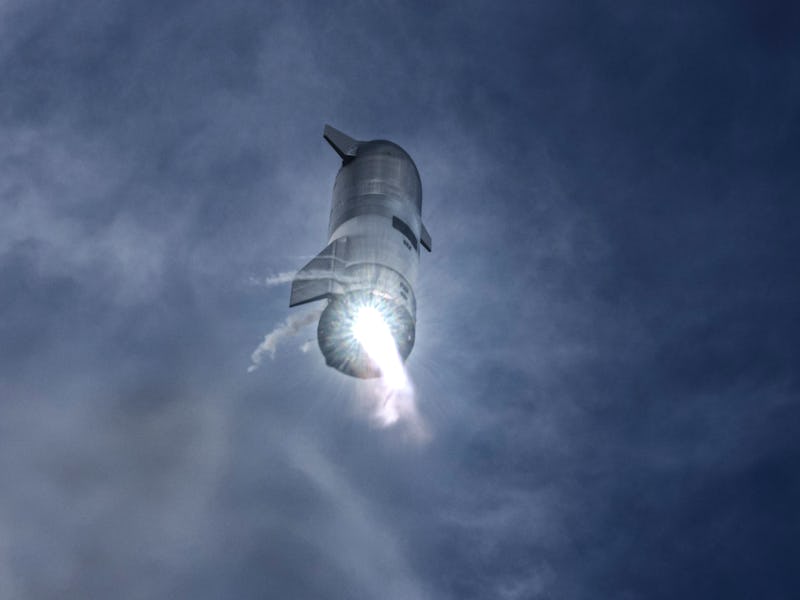SpaceX Starship: Elon Musk reveals a genius way it solves a major problem
The firm's Mars-bound rocket could play a key role in solving a big space travel issue.

SpaceX’s Starship could become the world’s most advanced garbage truck.
CEO Elon Musk recently claimed via Twitter that the firm’s under-development rocket will play a role in clearing up Earth’s orbit. Starship, which is primarily designed to launch crew and cargo into space for SpaceX, could use the fairing door that protects cargo to also collect up debris.
“Yes, we can fly Starship around space & chomp up debris with the moving fairing door,” Musk wrote on July 3.
It’s a feature that could solve one of the biggest concerns around humanity’s future in space: what do we do with all that debris floating around? (You can read more about the growing issue of space debris in the latest issue of Musk Reads+, Inverse’s premium newsletter on all things Elon Musk.)
Want to find out more about SpaceX’s plans for Starship? Subscribe to MUSK READS+ for exclusive interviews and analysis about spaceflight, electric cars, and more.
Details on Musk’s proposal are thin, but it would seem to involve using the protective fairing at the top of the Starship.
First unveiled in 2017 under the name “BFR,” the ship is a fully reusable rocket designed to send around 100 people to space at a time. It’s designed to take over satellite launches from existing rockets like the Falcon 9 and Falcon Heavy, while also enabling more ambitious missions like a crewed trip to Mars.
During the CEO’s 2017 presentation, Musk showed that the payload area would have a pressurized volume of 825 cubic meters in its crew configuration, larger than an Airbus A380 aircraft.
The Starship user guide shows how, in its cargo configuration, the fairing flips open to deploy its payload:
SpaceX user guide that shows Starship deploying.
The guide also outlines the ship’s ability to capture objects in space and bring them to Earth:
“With a fully reusable Starship, satellites can be captured and repaired in orbit, returned to Earth, or transferred to a new operational orbit.”
In short, capturing debris is something Starship may be able to do. According to Musk, you could think of the ship as a giant Pac-Man flying around in space and eating up satellites, instead of cherries and ghosts.
But whether it makes sense to use the giant ship for this is another question. In 2019, Musk claimed on Twitter that one of the much smaller Starlink satellites could also be used as a debris collector.
SpaceX is not the first to suggest a removal system for cleaning up space. Astroscale launched a demonstration of its space debris removal system in March 2021, designed to capture satellites and de-orbit together:
SpaceX has gradually improved its Starship prototypes, sending the SN15 model to a height of 32,800 feet in May 2021. The ship’s first flight to orbit is expected later this year.
Assuming it all goes to plan, SpaceX has big plans with its new rocket. A crewed flight around the moon with Japanese billionaire Yusaku Maezawa is scheduled for 2023, while Musk is aiming to establish a full-blown city on Mars by 2050.
It’s not the first time that SpaceX has suggested using the Starship to clean up space. In an October 2020 interview with Time, company president Gwynne Shotwell said that it’s "quite possible that we could leverage Starship to go to some of some of these dead rocket bodies... other people's rockets, of course... basically, go pick up some of this junk in outer space."
“It’s not easy, it’s not going to be easy, but I do believe that Starship offers the possibility of going and doing that,” Shotwell said.
When it comes to ambitious plans, Musk and Shotwell are very much in sync. In April 2018, discussing the firm’s goal to reach Mars and start a city, Shotwell described Mars as “fine” but added that it’s the first step toward reaching even more planets.
THE STARSHIP’S JOURNEY SO FAR:
- November 2018 — BFR, first announced in September 2017, gets renamed to Starship.
- December 2018 — Musk confirms the new ship has switched to stainless steel.
- January 2019 — Shortened “Starhopper” prototype unveiled and Musk explains the switch to steel.
- February 2019 — Raptor engine beats a long-standing rocket record.
- April 2019 — Starhopper completes a tethered “hop.”
- July 2019 — Starhopper launches 20 meters (67 feet).
- August 2019 — Starhopper launches 150 meters (500 feet).
- September 2019 — Starship Mk.1 full-size prototype unveiled.
- May 2020 — Starship SN4 full-size prototype completes a static test fire.
- August 2020 — SN5 launches 150 meters (500 feet).
- October 2020 — SN8 completes the first triple-Raptor static fire.
- December 2020 — SN8 launches 12.5 kilometers (41,000 feet) and crashes into the ground.
- February 2021 — SN9 launches 10 kilometers (33,000 feet) and crashes into the ground.
- March 2021 — SN10 launches 10 kilometers (33,000 feet), lands, and explodes eight minutes later. That same month, SN11 launches 10 kilometers (33,000 feet) and hits the ground in several pieces.
- May 2021 — SN15 launches 10 kilometers (33,000 feet) and lands without a hitch, except for a small fire at the base.
SUBSCRIBE TO MUSK READS+, A PREMIUM NEWSLETTER THAT COVERS THE WORLDS OF ELON MUSK, SPACEX, TESLA, AND EVERYTHING BETWEEN.